
Many a great horror movie gained its place of honor in film culture partly due to its images of evil. There's Hannibal Lecter muzzled like a mad dog, Leatherface in a taxidermized mask, Dracula's sharp tuxedo, and other such sartorial miracles of materialized malevolence. Jordan Peele's Us adds another unforgettable sight to this gallery of rogues. With their red jumpsuits and golden shears, the Tethered are one of cinema's newest and most complex monstrosities, as memorable as they are frightening…
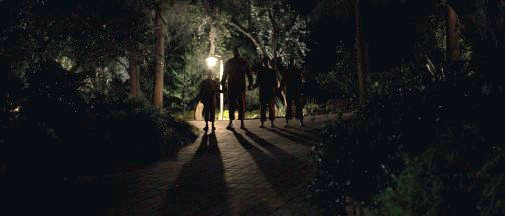
Before Us, Kym Barrett hadn't done much work in the world of horror, but her filmography is full of iconic outfits nonetheless. The black ensembles from The Matrix were her doing, as is the case of the angel dress from Romeo + Juliet, and The Nice Guys' 70s style. Throughout her career, the Australian costume designer even dressed the cast of Cirque du Soleil in Na'vi splendor for an Avatar-themed show. While frightening audiences may not be Barrett's specialty, she's costume design royalty, and her work in this Lupita Nyong'o-starring nightmare is a testament to her versatility.
Working closely with Peele, Barrett devised a look based on an odd dichotomy between realism and oneiric eeriness. On the one hand, there's an attempt to ground this nightmare in visceral reality, gritty and far too close for comfort. On the other hand, however, we find the Tethered's undeniable theatricality. Those doppelgängers who have spent their lives trapped underground, living as reflections of the people above, know how to make an arresting impression. Their attire may be utilitarian, but one shouldn't ignore its stylistic brio or the clues it gives to the origin of their revolution.
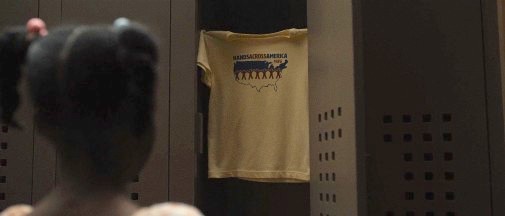
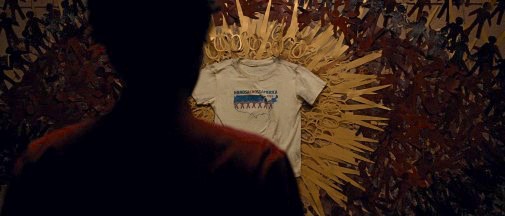
On the fateful night, when everything changed for poor little Adelaide, she was clothed in two pieces of 80s iconography. First, a shirt with the silhouettes of the "Hands Across America" logo. Second, there was a baggy t-shirt promoting Michael Jackson's Thriller that her dad won at a carnival. The Tethered uniforms are these nostalgic ideas, memories of the red jacket from the music video, and the human shapes from the logo metastasized into sinister uniforms. The leather gloves (only one worn by each person) also ring with Michael Jackson echoes and a bit of Freddy Krueger too.

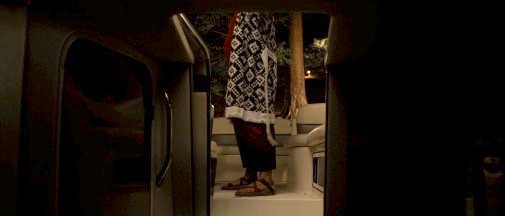
The repetition of clothes imbues the Tethered with cult-like eeriness. Just as the jumpsuit, the gloves, and the shears, the footwear's uniform, with everyone wearing the same clunky sandals that make the Tethered look like pilgrims traveling the desert, faithful believers following their Red Messiah – this is their Exodus. One can't help but look at those shoes since Barrett has designed the suits to have cropped legs and sleeves. The bones of the ankle and the wrist are always exposed. It's a reminder of the Tethered's humanity and a canvas to show off the blood they shed. After all, in the red fabric, it's hard to see splatter.
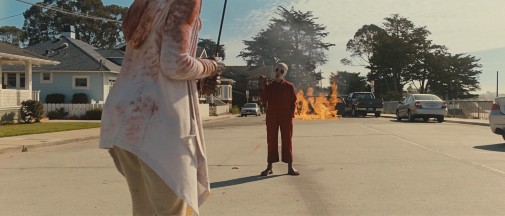
The jumpsuits aren't a solid color, though. The center is darker and bolder, while the extremities fade into a duller tone. In many ways, the tethered look like pools of blood whose edges have dried out, the middle still gooey and hot. The symbology of the color extends beyond its sanguine connotations. Red is, after all, the name of the Tethered's leader, Adelaide's doppelgänger. Just as her destructive action grows, so does the color slowly bleed into the film until it consumes the whole thing. It starts with a candy apple and ends in a crimson stripe painted across the United States, coast to coast like the fleshy gash left by the strike of a guillotine.
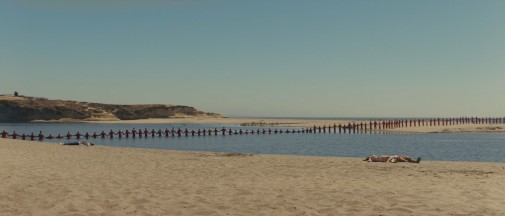

At this point, you may have noticed that I'm crazy for the Tethered red jumpsuits, but that's not the only costume in Us worth exploring. The main look of the villains may be memorable, but it isn't even their only outfits. Later in the picture, during flashbacks, we get to see the underworld before Red's revolution started. Then, they were dressed in plain versions of the costumes from above. Details are missing and everything is more rumpled than it should be, stained with sweat, but their clothes tie them to the people on the surface like strings on a puppet.
It's a stylistic photocopy, faded and rumpled, smeared with gunk and stinking of suffering. What could be more appropriate for a movie about dualities, twisted reflections, and terrifying facsimiles?
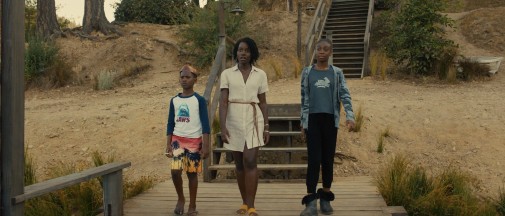
As for the above world, it's washed out in white, grey, and cream, sun-bleached fabrics that contrast violently with the scarlet boldness of those who never see the sun. The people above are dressed in light colors. They are enshrined in the light the people who were born in darkness wish to obtain. There's also the fact that while the red jumpsuits hide the blood, the main family's pale cotton shows every crimson drop. That dyeing effect of blood is especially noticeable in Adelaide's ensemble.
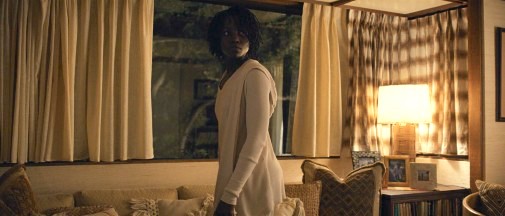
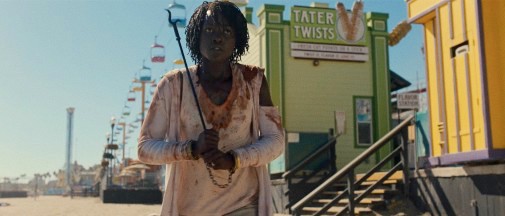
As the film unfolds, she becomes covered in red, painted by it, until it's difficult to tell what original color her garments were. The barrier between doppelgänger and original is thus becoming all the more tenuous and immaterial, a dangerous truth that's spelled out by the costumes before the movie's narrative makes it clear. Furthermore, Adelaide's clothes are almost pathologically anonymous, inhuman like a person suit for an alien. They're so simple, it's difficult to parse out her personality from looking at Adelaide. That's not a dig at Barrett since this is a deliberate, purposeful choice.
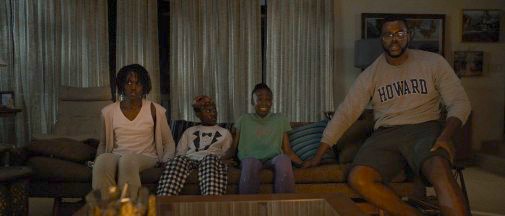
In contrast, the rest of Adelaide's family is dressed in clothes full of personable details. Winston Duke's Gabe wears his cool dad fashion with ease and a good dose of sexiness, while his Howard University jumper firmly establishes him as a part of Black American middle-class. According to Barrett, that piece was aged and subtly broken down. It's supposed to be a favorite shirt, something worn so often it's become molded to the body, a second skin of sorts. Those details may seem negligible, but they make all the difference in the end.
Shahadi Wright Joseph's Zora is more colorful than any of her family members and, at one point, she even gets to don some bunny motifs – a cutesy reflection of the underground ecosystem, where the Tethered feed on raw rabbit meat. Adelaide's son, Evan Alex's Jason, is a whole different story, being an amateur magician whose identity embodies some of the movie's main themes. Naturally, that's present in the costumes as well as in the text.
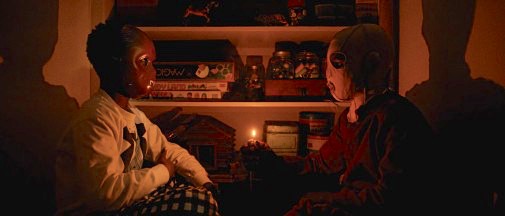
His tuxedo printed shirt and matching black and white pants recall an illusionist, though this kid performs in the bedroom rather than the stage. On another level, the tuxedo print carries symbolic weight as clothing disguising itself as different clothing, a dissimilar twin of formalwear whose fakeness is funny to the observer. His Halloween mask is a similar token of illusion and reflection, pretention, and monstrous duplication. When they're wearing their masks, Jason and his Tethered don't seem so odd, their likeness and mutilated contrast hidden from our eyes.
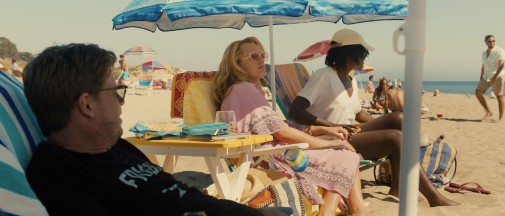
Even Elisabeth Moss' Kittie Tyler and her brood, all relatively minor characters, have more sartorial personality than our supposed heroine. They are decked out in downplayed tacky chic, wealth manifested in vodka-soaked pink beachwear and ironic designer t-shirts. Overall, there's a charming simplicity to the costumes of Us that lets the actors' bodies and physical performances take precedence over the clothes they're wearing. Still, the costumes tell us plenty about their models and when they don't, it's difficult to ignore.
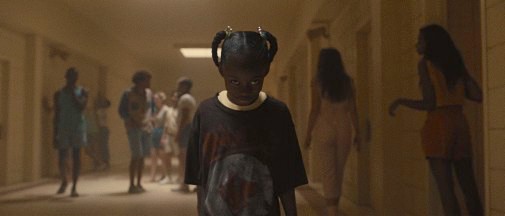
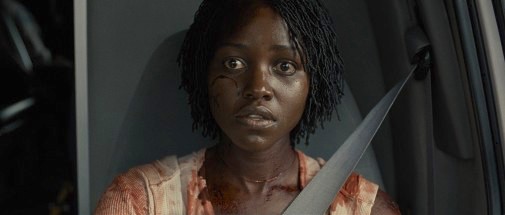
Through her designs, Kym Barrett is warning us, telling us that there's something wrong. In Us, there's always evil hidden in plain sight.